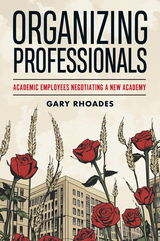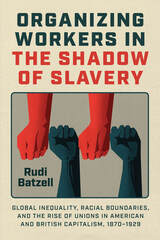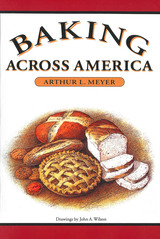
Whether it's a slice of warm bread and butter, a Thanksgiving pumpkin pie, or a piece of cake, baked goods have been among America's favorite comfort foods ever since the Pilgrims arrived. From the days of hand mixing and baking on the hearth to today's use of food processors and electric ranges, American cooks have created an amazing variety of breads and baked goods that are as distinctive as the cultures from which we came.
Spanning colonial times to the present and every region of the United States, this book is a comprehensive guide to baking in America. Certified master baker Arthur L. Meyer brings together some 700 kitchen-tested recipes for America's favorite breads, pies, cakes, and cookies. Compiled from almost 300 regional cookbooks dating from the 1890s to the 1980s, these are the authentic recipes for the traditional baked goods of every part of our country. In these pages, you'll find regional specialties such as Appalachian Buttermilk Cracklin' Bread and Hawaiian Pineapple-Macadamia Bread, as well as old family recipes.
In addition to the recipes, Meyer offers a fascinating overview of the history of baking in America, complete with descriptions of early breads, pies, cakes, and cookies. Whether you're a home or professional baker, a food historian, or someone who just enjoys reading cookbooks, you're sure to find lots of tasty treats here. Let Baking across America become your basic source for all the baked goodies Americans love to eat.
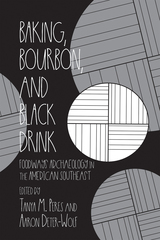
Understanding and explaining societal rules surrounding food and foodways have been the foci of anthropological studies since the early days of the discipline. Baking, Bourbon, and Black Drink: Foodways Archaeology in the American Southeast, however, is the first collection devoted exclusively to southeastern foodways analyzed through archaeological perspectives. These essays examine which foods were eaten and move the discussion of foodstuffs into the sociocultural realm of why, how, and when they were eaten.
Editors Tanya M. Peres and Aaron Deter-Wolf present a volume that moves beyond basic understandings, applying new methods or focusing on subjects not widely discussed in the Southeast to date. Chapters are arranged using the dominant research themes of feasting, social and political status, food security and persistent places, and foodways histories. Contributors provide in-depth examination of specific food topics such as bone marrow, turkey, Black Drink, bourbon, earth ovens, and hominy.
Contributors bring a broad range of expertise to the collection, resulting in an expansive look at all of the steps taken from field to table, including procurement, production, cooking, and consumption, all of which have embedded cultural meanings and traditions. The scope of the volume includes the diversity of research specialties brought to bear on the topic of foodways as well as the temporal and regional breadth and depth, the integration of multiple lines of evidence, and, in some cases, the reinvestigation of well-known sites with new questions and new data.

The Emily Dickinson manuscripts are a cherished part of Houghton Library’s collections and—while it is her poems and letters that are most often celebrated—the poet’s lesser known lines: “2 Butter. / 19 eggs. / 5 pounds Raisins” are also cause to celebrate.
Dickinson’s manuscript recipe for black cake, from which these lines come, was sent along with a bouquet of flowers to Nellie Sweetser in the summer of 1883. Black cake is a traditional Christmas specialty closely related to the English fruitcake, “blackened” with the addition of burnt sugar syrup or molasses. It was generously spiced with nutmeg, cinnamon, mace, and clove before being wrapped in brandy- or rum-soaked cloth and often aged at least a month. The recipe, though somewhat shocking to a modern reader (19 eggs!), turns out to be remarkably orthodox in its ratios, if not its scale. Fully assembled, the recipe produces batter weighing in excess of twenty pounds.
Delve into the history of this majestic cake and explore the story of each ingredient, in the context of Emily Dickinson’s nineteenth-century Amherst home, with librarians of Houghton. Each ingredient is accompanied with watercolors by Robin Harney evoking Dickinson’s moment in time and moments in the kitchen.

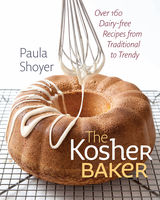
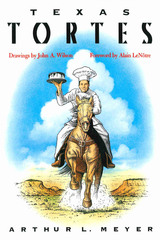
With layer upon layer of rich, dense cake and delicate buttercream subtly flavored with fruit, chocolate, or nuts, classic European tortes crown the pinnacle of Old World baking. Make them with the freshest produce of the fields and orchards of Texas—oranges, peaches, pecans, raspberries, blueberries, plums, apricots, figs, strawberries, and kiwis—and you will discover the New World's ultimate desserts.
In this cookbook, Master Baker Arthur L. Meyer presents forty-three original, kitchen-tested recipes for fruit, nut, and chocolate tortes, cassate, tarts and pies, cheesecakes, and other classic European desserts. The recipes take advantage of fresh Texas ingredients, and each recipe contains clear, easy-to-follow instructions that demystify the processes involved in creating these desserts.
In addition to the recipes, Meyer guides the home baker through the basic steps in producing tart and cheesecake crusts, fillings and icings, and other standard components of special desserts. Throughout the book, he gives tips on proper techniques and equipment drawn from many years of experience.
READERS
Browse our collection.
PUBLISHERS
See BiblioVault's publisher services.
STUDENT SERVICES
Files for college accessibility offices.
UChicago Accessibility Resources
home | accessibility | search | about | contact us
BiblioVault ® 2001 - 2025
The University of Chicago Press





